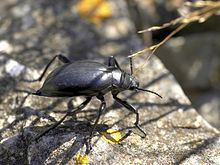Scientific name Tenebrioninae Higher classification Darkling beetle | Order Coleoptera Rank Subfamily | |
 | ||
Lower classifications Mealworm, Mealworm Beetle, Cellar beetle | ||
Tenebrioninae are a large subfamily of the darkling beetles (Tenebrionidae), containing, among others, the flour beetles.
Contents
Many of these robust and usually mid-sized beetles have elytra with some sort of corrugation on the upperside. They are usually colored blackish, dark brown or grey, and often have a satiny sheen; they are generally not glossy (some are outright matte) and few are metallic. The body is shaped like a medication capsule or like a bullet; the legs can be short and stout or long and spindly. They eat both fresh and decaying vegetation, including vegetable produce, and several are commercially important pests of flour and other cereal products.
Tenebrioninae are eaten by large invertebrates and small vertebrates, such as birds, rodents, and lizards. The larval stages of several species are cultured as feeder insects for captive insectivores, and include mealworms and mini mealworms.
Notable species
The mealworm beetle (Tenebrio molitor) is commonly used as food for terrestrial amniotes kept in terraria. Other Tenebrio and Tribolium species are also bred as animal food. The red flour beetle (Tribolium castaneum) is a popular genetics laboratory animal and model organism, especially in studies of intragenomic conflict and population ecology. Several species of Tenebrio and Tribolium, such as the confused flour beetle (T. confusum) and T. destructor, and other genera such as Gnathocerus cornutus, are pests of cereal and flour silos and other storage facilities.
Systematics
The Tenebrioninae are traditionally divided in some 20-30 tribes. The exact delimitation and validity of several of these is unclear. Molecular phylogenetic studies have yielded inconsistent results, perhaps due to hybridization, horizontal gene transfer by Wolbachia bacteria, and insufficient taxon sampling obfuscating the information contained in DNA sequence data.
In some treatments, the Pimeliinae are included as yet another tribe. This may be correct, but as far as can be told they are a closely related but well distinct lineage of Tenebrionidae. The Opatrini are sometimes elevated to familial rank as Opatrinae. The Crypticini, Pentaphyllini, and Scaphidemini are sometimes placed here, but are more commonly located in the Diaperinae.
The tribes (and some notable genera) include:
Helopini Latreille, 1802
In addition, the genus Aphtora is of uncertain placement in this subfamily.
